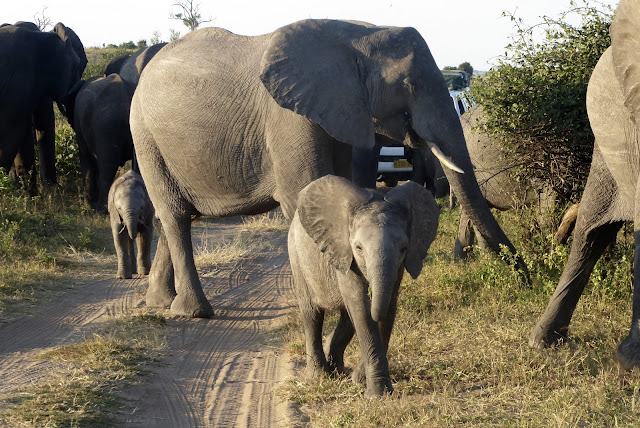Our first safari experience was in Chobe National Park, Botswana. It is 11,000 square kilometers. We only saw a fraction of the park. We enjoyed 4 game drives in the park during our stay in Botswana. On morning game drives, we arrived at the park a little after 6 am. Afternoon game drives began about 3:30 and continued just after dark.
The entrance to the park displays a large collection of skulls found in the park.
On one of our morning drives, we encountered a hippo heading back toward the river. These large mammals spend their days in the water and many of their nights on land grazing on grass. It doesn't look like it, but they can apparently run 25 mph (only for short distances, but perhaps long enough to get to you).
We saw several baboon troops on our game drives. This tree is full of baboons.

Impala like to graze under trees to catch what the baboons drop.

We saw dozens of bird species during our trip. Here's a helmeted guinea fowl!
Here's a secretarybird, a bird of prey that hunts primarily on foot, walking around in the grass to flush out small animals.
Another ground-dwelling bird is the kori bustard, the largest flying bird native to Africa and the national bird of Botswana.
A yellow-billed hornbill.

We saw many ruminant animals including waterbuck, the largest antelope they have here.
Impala.
An impala tip-toeing past a resting crocodile.

Kudu.

We also saw hundreds of Cape Buffalo, one of the Big 5 game animals.

Warthogs cross the road.
In Botswana, we rode around in four-wheel drive Nissan trucks that had been modified to carry 10 passengers.

Chobe has the largest concentration of elephants in Africa, accounting for something like 20% of the entire population.
Elephant carcass. We don't know what happened to this one, but Chobe is one of the few places in the world where the lions have adapted to hunt elephants.
Zebra!
Each game drive involves a coffee or beer break.
We saw numerous giraffes on our game drives. One interesting thing we learned is that giraffes walk with a parallel gait, moving legs on the same side at the same time.


On another occasion, we saw a herd of elephants with many babies.
Sometimes you have to wait for the elephants to cross the road before you can move along.
And we learned where elephant babies come from.
Impala were on alert because of her presence.
The baboons didn't seem to care as much.
And saw a business of banded mongoose.

















































No comments:
Post a Comment